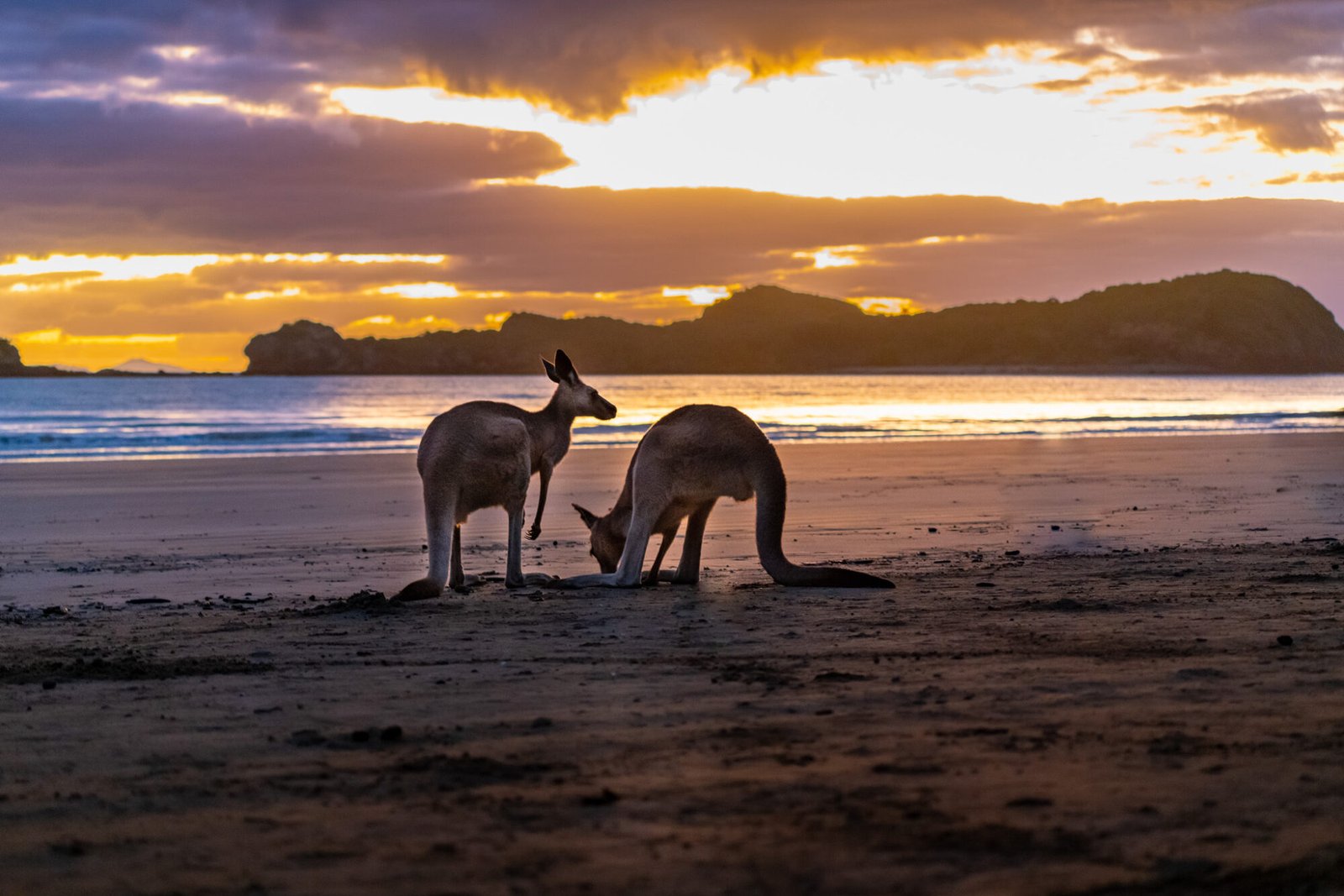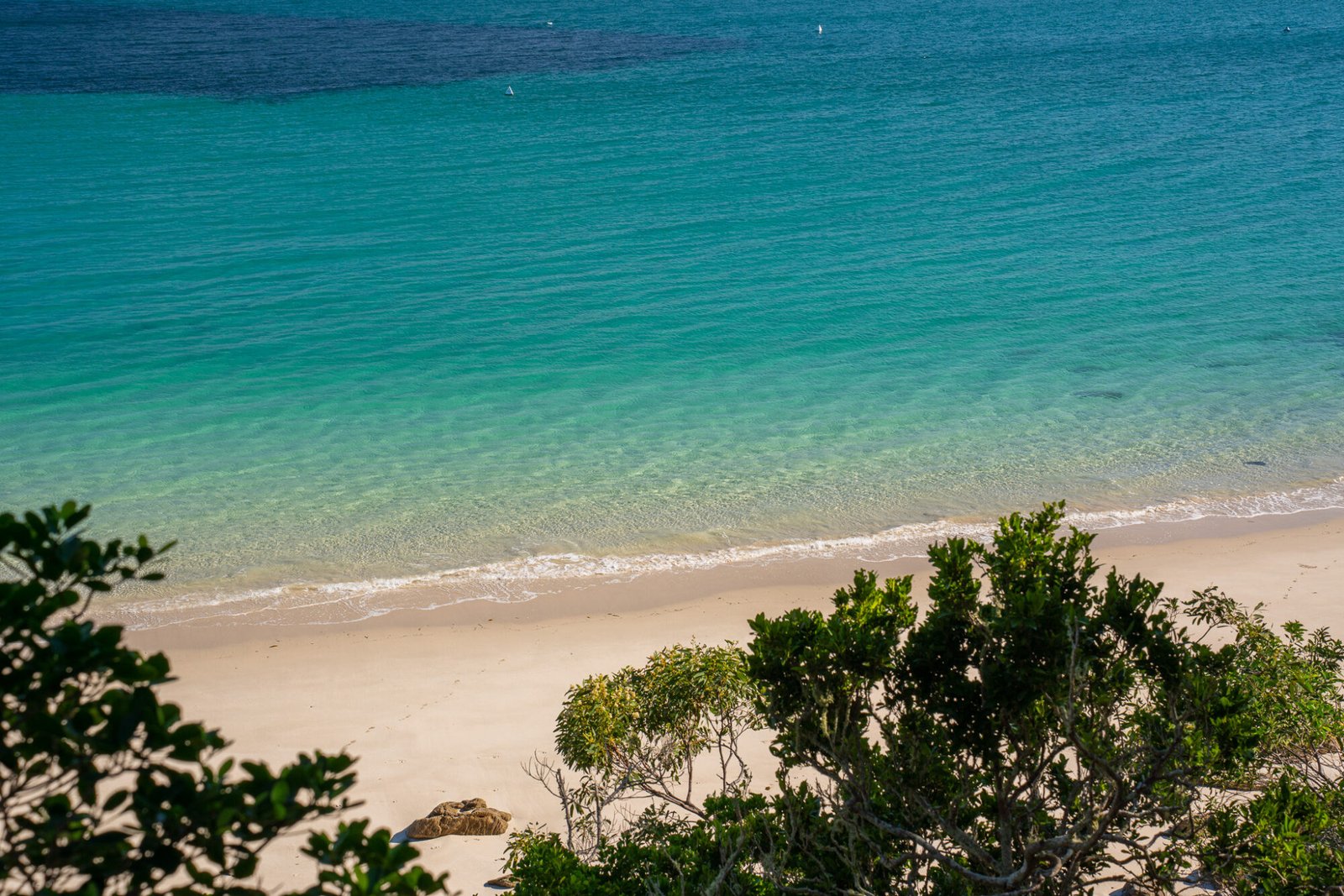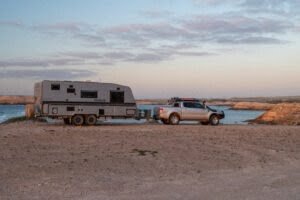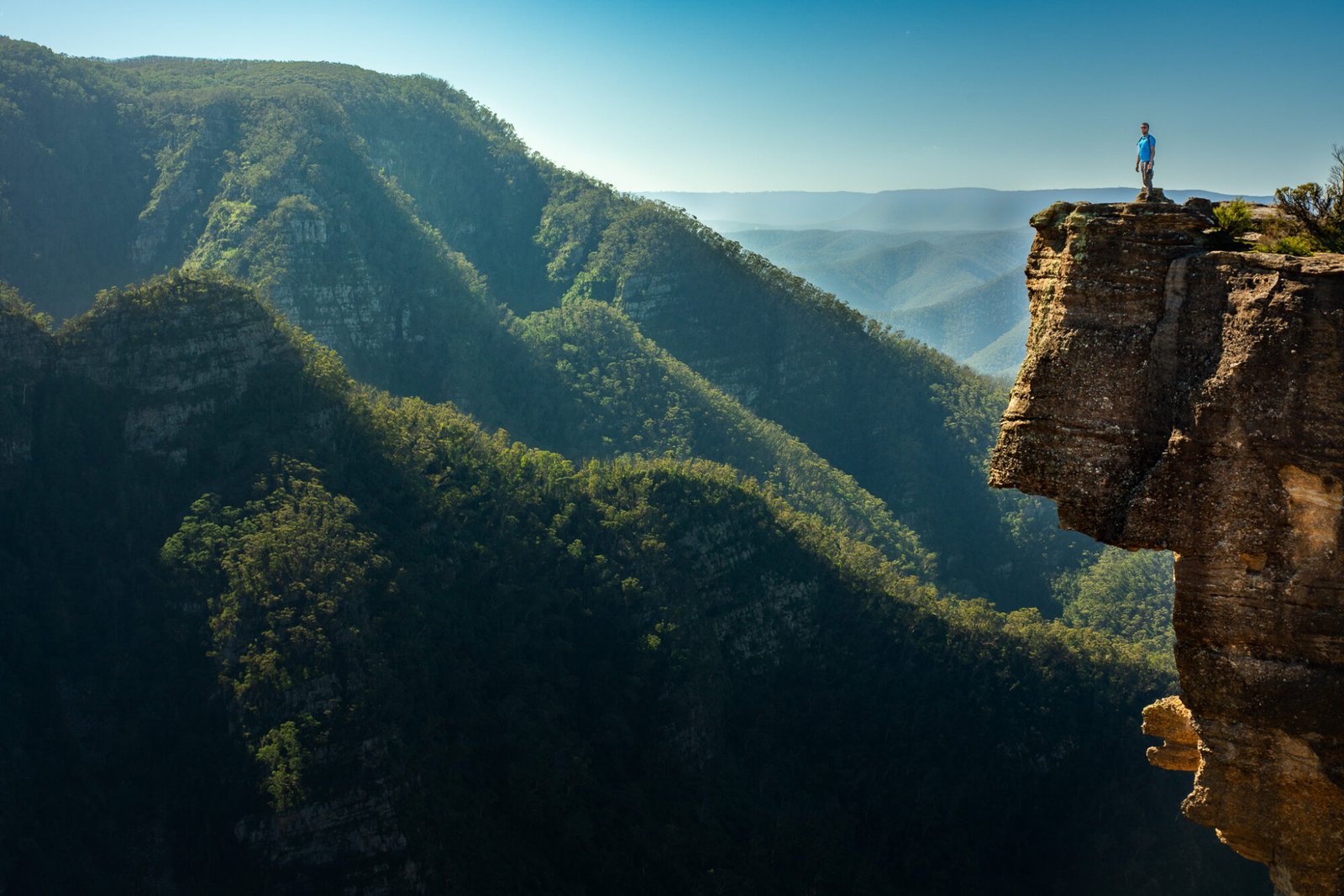Ever had people talk up a place so much that when you finally get there, you’re actually a bit disappointed because it isn’t quite what you had pictured? Well, Karijini National Park is NOT one of those places. With its never-ending canyons and gorges and pristine swimming holes, all with an underlying feeling of adventure as well as a sense of sacredness to it, Karijini is a must-do on a big lap itinerary. There are not enough words in existence in the English language to adequately describe this place, but we’ll give it a try…
Driving through the inland Pilbara region from Exmouth is a great intro into the type of scenery you’ll get at Karijini as colossal deep red, spinifex-covered cliffs start to rise up all around you.

The town of Tom Price is your last stop for supplies before entering the park, and it’s a smart idea to stock up as the town is a good hour or so away from the campgrounds. While in town, take the short drive up the 4WD-only track (or walk up if you’re feeling really keen!) to the top of Mount Nameless (which actually does have a name – Jarndunmunha to the local Aboriginal people). At 1128m, it is one of the tallest in Western Australia. From up here you get sweeping views over the Pilbara countryside, including the active mining sites that gave rise to Tom Price township.

Tom Price, an American who came to Australia in the 1960s, was the main driving force for the establishment of the mining industry in this extremely remote part of Australia. He passed away within only hours of learning of the discovery of extremely rich ore deposits in the region he had just appraised.
There are two options for camping in Karijini. One is at the Karijini Eco Retreat in the central portion of the National Park, on the road to Hancock and Weano Gorges. The other option, where we stayed, was at Dales Campground on the eastern side of the park, within walking distance to Fortescue Falls, Fern Pool, and Circular Pool.

There aren’t many shady sites available and only some parts of the camp allow generators, so do your research beforehand to find the site best suited for your setup. We got to Karijini in mid-October, which we felt was one of the best times of year to visit. It’s starting to get less busy, and it’s warm enough for the swimming holes to feel refreshing instead of icy (it can get below freezing here in the winter!) but not too hot that it’s unbearable. The park in the summer months can get extremely hot (in excess of 45 degrees C) and can close due to flash flooding. We’d imagine the other best time to visit the park would be in April when temperatures are starting to cool down, the water is flowing nicely, but the crowds haven’t arrived just yet. There are free camps on the outskirts of the national park, as well as two caravan parks nearby, but if you’re spending a decent amount of time here, it’s well worth staying in the park itself to avoid lots of time in the car and having to drive at night, dusk or dawn when animals are more likely to be active. After all, Karijini is WA’s second largest national park, and although the southern half of the park is mostly inaccessible, there is still a lot to see and a fair bit of distance between attractions. So when it comes down to it, camp is simply a place to rest your weary body after a day of epic adventuring; the real draw is all the gorges and swimming holes that are to be explored.
FORTESCUE FALLS AND FERN POOL
The beauty of staying at Dales Campground is that there are two of the best falls in the park within walking distance from camp. I’d say “easy walking distance” except for the fact that you have to climb down a fairly long stretch of stairs to get to them. Not so much of a problem on the way down, but it will most definitely getting you huffing and puffing on the way back up. Nevertheless, you’ll forget all about the cardio workout involved once you reach Fortescue Falls, a beautiful stepped waterfall nestled in a deep amphitheatre of stone.

It is the only permanent waterfall in the park, and there are plenty of ledges perfect for bringing a picnic, for having a rest, or for looking out soaking in the absolute beauty around you. A small detour to the right from the bottom of the stairs will take you to the spring-fed Fern Pool, which makes you feel like you’ve been transported to some sort of lush, water-filled fairyland. It also has a great significance to the local Aboriginal people, who call the waterhole “Jubara.” It was traditionally known as a women’s place and where the Dreamtime Serpent settled after carving out all the gorges and canyons of the surrounding region; therefore, it is requested to keep noise to a minimum out of respect when in this special place. You can float around in the small pool or sit in the fern-fringed caves below the falls and enjoy the tranquility.

DALES GORGE AND CIRCULAR POOL
The walk through Dales Gorge is a mostly easy 2km walk following the creek that trickles on from Fortescue Falls. You’re likely to see a fair bit of bird life, lizards, and possibly even bats along the walk.

At the opposite end of the gorge lies Circular Pool. Unfortunately for us, Circular Pool was closed during our visit because of a recent rockfall and increased asbestos risk (oh yeah, there’s a whole lot of blue asbestos in the area…but don’t worry, it’s not usually a cause for concern!). From the lookout above, it seemed to be an idyllic place for a swim, with greenery climbing up the sheer cliffs walls surrounding a pretty little pool. Be aware that the climb up/down Dales Gorge from that end is a lot more scrambly, compared to the steps at the other end.

JOFFRE AND KNOX GORGES
From Dales Gorge, there are two options to get to the gorges and waterholes in the central portion of the park. The first, longer route is to go along the highway and take the turnoff onto the sealed portion of Banjima Drive. The second, potentially shorter trip is to take the unsealed road west from the info centre. It is highly advisable to check on the condition of the unsealed road before you take it; when we were there, it was actually quicker to go out to the highway and around due to the poor condition of the road.
Joffre Gorge has a couple lookouts with great views, but to fully appreciate it, the climb down is a must. Most of it is fairly easy with a bit of rock-hopping/climbing to get to the bottom. We actually had a very unique and memorable experience here. Just as we started the climb down, we noticed a couple looking at something very intently. When we got around to them, we saw what it was: a large olive python in the process of eating a cockatoo! We watched for a while, mesmerised, as this several meter long snake wrapped around the bird, dragged it a bit of way, then unhinged its jaws and proceeded to swallow its meal whole…a real National Geographic-type experience!

We continued our climb down, and, after having a look at the dry Joffre Falls (which rarely flows), we decided it was time for a swim. This is one of the longer swims in the park, probably about 200 meters each way; you can always perch yourself on the side for a rest or bring a flotation device if you’re not a confident swimmer to make it easier. It’s well worth the effort though, swimming through the towering gorge to get to the little island at the end. We thoroughly enjoyed sitting here, listening to the bird calls echoing off the gorge walls, watching goannas hunt for their next meal. Being one of the less popular spots, it’s a great way to feel like you’ve really escaped from it all and are truly amongst nature.

If you continue along the unsealed track, you’ll reach Knox Gorge after about 6km. There’s a short but steep and scrambly climb into the gorge with minimal shade, so this one is best done at the start or end of the day. Once you reach the bottom, you have a few peaceful but not very swimmer-friendly pools to your right, or following the gorge to the left will take you to some of the bigger swimming holes with a little cascading waterfall at the end.

KALAMINA GORGE
Heading back to the sealed portion of Banjima Drive, there is the option of taking another unsealed road to Kalamina Gorge and the Information Centre. As mentioned previously, the road can be severely deteriorated, so check with the info centre before attempting. We put our tyre pressure down a bit and didn’t have any issues. Kalamina Gorge has fairly easy access into it. To the right, you have the pretty Kalamina Falls.

To the left, you follow the gorge and waterway until you get to Rock Arch Pool, a nice swim-able pool with some interesting rock formations. While we wouldn’t say it’s the best gorge and waterhole in the park, it’s well worth a look if you have the time.
HANCOCK AND WEANO GORGES
Toward the end of the sealed portion of Banjima Drive, before the turnoff to Joffre Gorge, is the turnoff for Hancock and Weano Gorges, as well as the road to the Eco Retreat. It can be done in a 2WD, but you’ll be a heck of a lot more comfortable in a 4WD. We did also come across a van with a smashed window from a rock, so be aware and drive to the conditions.
From the carpark, access to Hancock Gorge is on your right. This one is probably the most interesting and adventurous of all the walks. It starts with climbing down steps and a ladder until you get to the bottom of the gorge. From there, you walk along the creek, at times either wading and swimming through some of the deeper water or opting to “spider walk” your way around them. Then it’s a matter of scooting and sliding down over rocks in a narrow chasm until you reach the beautiful Kermits Pool, a surprisingly deep pool framed by layered rock.

Back at the carpark, you have the option of taking the Upper Weano gorge walk (a nice walk but not one we’d really rate) or go straight to Lower Weano and the main attraction of the gorge, Handrail Pool. From the easy walk through the gorge, you’ll reach a narrow chasm with a handrail attached to it, useful due to slippery ground, which eventually leads to a climb down into an open high-walled pool.

There are places to sit and enjoy the beauty or for the more adventurous, you can continue the swim a bit further. Be warned, the water gets little sunlight so it is icy! Nevertheless, there is something special about sitting at the end of that extra stretch of chasm, listening to the sounds of nature or even the sound of complete silence, that is worth experiencing.
HAMERSLEY GORGE
Last but certainly not least is Hamersley Gorge, situated on its own little corner in the northwest section of the national park. It’s a fair distance from both park campgrounds so keep that in mind for fuel and supplies. Being a mostly unsealed road out to the gorge means it can be in any condition; however, being a road used by mining companies means it’s generally well looked after. Access into the gorge is by rock steps down to a lovely open pool.
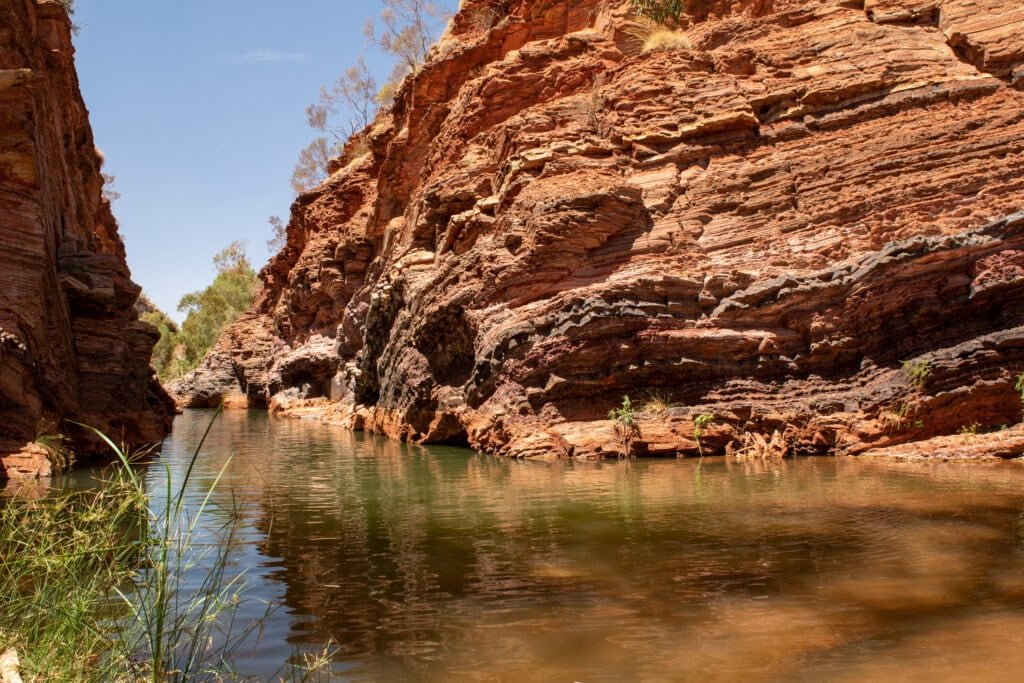
Going left, you can swim down for a bit, exploring ledges until the water runs out and the bush takes over. Going right involves rock-climbing up the slope, with an optional swim to the main attraction: Spa Pool.

Probably the most photographed attraction in Karijini, this perfect little circular pool being fed by a small waterfall will be hard to tear yourself away from. You can continue the climb up a bit to the rock pools above but will always find yourself coming back to the Spa Pool. The colours and brilliance of Hamersley Gorge shift and change throughout the day, making it the perfect place to spend some extended time.
MOUNT BRUCE
It’s not all just gorges and swimming holes in Karijini, there are some tall mountains around too. The tallest mountain in WA, Mount Meharry at 1249m high, is a bit out of the way, but can be conquered either on foot or via a tough 4WD track. If you can’t quite make it out there, the second tallest, Mount Bruce (Punurrunha), is only 14 meters shorter and much more central and can only be summited on foot.

It’s highly recommended to climb Mount Bruce early in the morning; there is not a lot of shade and the Pilbara can get brutally hot during the day. We started the climb at first light and on our return, we passed some very overheated-looking people. The walk itself is 9km return and will take about 5-6 hours. It mostly follows a ridge to the top but does involve some climbing up and down rocks. The view is worth the effort though!
For our first glimpse into the Pilbara, Karijini set the bar high; there is no denying it is the jewel of the region. In our next post, we detail our travels through coastal Pilbara from Exmouth to Broome along the Warlu Way, with a small detour inland to Marble Bar, also known as Australia’s Hottest Town!

